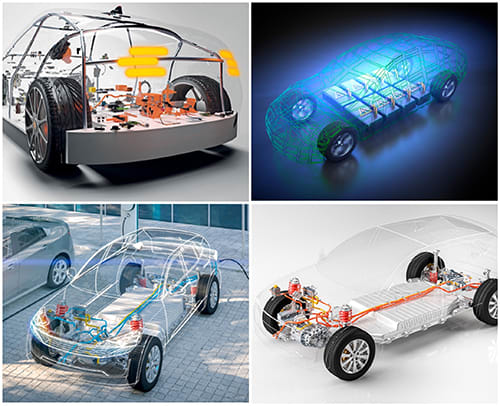Learn about the three levels of North American EV charging and how TE Connectivity components are helping these electric vehicle charging technologies evolve.
Juan Alberto Duran, Americas Key Account Manager, TE Connectivity; Jordan Wainwright, Integrated Marketing Analyst; and Dave Barrington, Distribution Sales Engineer – Electronic, Industrial, Southwest
To the average consumer, an electric vehicle (EV) is just like a car, but instead of an internal combustion engine (ICE) and a gas tank that you fill it has an electric motor and a battery that you charge. And in terms of the 10,000-foot view, that’s correct. For the engineers who design EVs, however, it’s a lot more complicated than that. As the old saying goes, God is in the details, and the details are where TE Connectivity comes in, providing an extensive portfolio of industrial components and solutions — ranging from connectors, sensors, circuit breakers, relays and contactors, connectors, passives, filters, switches, cable assemblies, electrical terminal blocks, identification solutions, and charging inlets to battery management systems and charging stations —optimized to support EV applications spanning electrification and control to charging.
Range per Charge and Charging Speed

In the early days of ICE vehicles, motorists embarking on long journeys always carried cans of gasoline because there was no telling where the next filling station would be. EV drivers currently face a similar challenge. But in this instance, hauling extra batteries along in case there isn’t a charging station within range isn’t a particularly feasible or economical solution due to both the size of the battery packs that power these vehicles and the rare — and thus costly — metals that help make them so powerful. However, unlike gasoline-powered vehicles, EVs often start each day with more “fuel” than they had the night before because they spent the night connected to a charging station.
Due to the uneven distribution of public charging stations at present, as well as the varying amounts of time it can take to charge an EV, range per charge and charging speed have a significant effect on EV adoption. As such, improving these two influential characteristics is the goal of a great deal of research and development efforts, and it will continue to be until most EVs can directly compete with the median driving range and fueling speed of gasoline vehicles, which, for 2016 models, was 416 miles per fill and roughly five minutes (U.S. DOE).
In the U.S., the median range per charge for all-electric, 2020-model EVs exceeded 250 miles, which is nearly four times the median range in 2011 and, as such, solid evidence of the impact of evolving EV technologies (U.S. DOE). This model year also marked the first EPA-estimated maximum range per charge of more than 400 miles (U.S. DOE). Range per charge still varies widely between brands and models, though, with 2021 all-electric models available in the U.S. offering a combined (city/highway) range per charge spanning 110 to 373 miles and averaging 242 miles (Car and Driver).
EV charging speeds are also improving at a similar rate and, depending on the charger and the capacity of the EV battery, can deliver two to 80 miles of range in anywhere from minutes to hours. There are currently three types of North American EV charging stations: Level 1, Level 2, and Level 3. Level 1 and Level 2 EV chargers utilize a lower-voltage AC power source, while Level 3 chargers utilize a high-voltage DC power source.

TE Industrial solutions is one of the many electronics suppliers empowering the future of EV charging infrastructure. TE Connectivity’s deep portfolio and engineering expertise meet the wide spectrum of customers’ international AC and DC charging needs. The value proposition for TE EV solutions includes charging that can meet higher current demands and differences in current between regions, higher voltage in a smaller envelope, faster and safer charging, and greener, cleaner, and more sustainable solutions.
Level 1 EV Charging Systems

All EVs come with at least Level 1 EV charging systems that are compatible with cordsets featuring a standard 120VAC household plug (e.g., a NEMA 5-15 three-prong plug) on one end and an SAE J1772 connector — the standard for the North American EV market — on the other. Even Teslas, which have a proprietary charging connector, come with a J1772 connector adapter so they can use industry-standard charging equipment. However, while Level 1 charging is convenient and inexpensive, allowing users to charge their cars at home using standard plugs and outlets, it’s not very practical for EVs driven more than 40 miles on a daily basis because it typically takes eight hours of charging at 120VAC just to achieve that range. Level 1 EV charging systems only deliver two to five miles of range per hour and can take 30 to 40 hours to deliver a full charge depending on the size of the EV battery. As such, Level 1 EV charging systems work best with plug-in hybrid electric vehicles (PHEVs), which have smaller batteries and a secondary fuel source, recreational vehicles, like golf carts, and EVs that are only used infrequently and for short distances. They currently account for less than 5% of public EV charging systems in the U.S. (U.S. DOE).
Level 2 EV Charging Systems
Level 2 EV charging systems employ the same J1772 connector as Level 1 systems, which allows all commercially available North American EVs to utilize both Level 1 and Level 2 charging systems. The Level 2 systems are also compatible with 240VAC outlets, which are typically available but not necessarily preinstalled in residences, and 208VAC outlets, which are widely available in municipal and commercial locations. These systems can charge EVs up to 10 times faster than Level 1 EV charging systems, delivering 10–20 miles of range per hour of charging and 80–160 miles of range with a typical eight-hour overnight charge. As such, they currently account for more than 80% of public EV charging systems in the U.S., as well as a growing number of home charging systems (U.S. DOE). Level 2 EV charging systems can operate at up to 80A and 19.2kW, but most residential installations employ a dedicated 40A circuit and operate at lower power, typically 30A and 7.2kW (U.S. DOE).
Level 3 EV Charging Systems
Level 3 EV charging systems, or DC Fast Charging systems, take EV charging to a whole new level, typically delivering 60–80 miles of range in just 20 minutes and providing a full charge for 2021-model U.S. EVs (which again feature range per charge values spanning 110 to 373 miles) in just 36–94 minutes (U.S. DOE, Car and Driver). However, the new Terra 360 Level 3 EV charging system from ABB, which is explicitly designed to charge up to four vehicles at once, can deliver 62 miles of range in less than three minutes, making it ideal for refueling stations, urban charging stations, and fleet operations. Level 3 EV charging also systems typically operate at a minimum of 480VDC and 100A (50–60kW), and since such high-voltage power supplies are not readily available in residential applications, these systems currently cost tens of thousands of dollars, and installations require commercial electricians to participate in the planning phase due to the load and wiring requirements, they are widely used as range extenders along major travel corridors. Although, their prevalence in urban environments is increasing — especially in locations where people typically spend 30 minutes to an hour, such as restaurants, recreational areas, and retail outlets — which allows them to provide critical support for EV owners without home charging capabilities or with high-mileage driving habits (CALeVIP). Currently, Level 3 DC Fast Charging systems account for just over 15% of public EV charging systems in the U.S. (U.S. DOE).

While these systems improve the feasibility of taking EVs on long road trips and are certainly helping to close the range and refueling gap between EVs and gasoline-powered vehicles, not every EV model is capable of DC fast charging. In addition, unlike Level 1 and Level 2 EV charging systems, which utilize a single standard connector (SAE J1772), there are currently three standard connectors for DC Fast Charging systems: SAE Combined Charging System (CCS) connectors, CHAdeMO connectors, and Tesla Supercharger connectors. The CCS connector is the standard DC Fast Charging connector for North America and is unique because it allows drivers to use the same charging port whether they’re charging their vehicle with a Level 1, Level 2, or Level 3 system. The only difference is that the CCS plug combines the standard five-pin J1772 connector with two additional high-speed charging pins.
Thermal Loading and EV Charging
All three charging systems increase the thermal load of the EV system, raising the temperature of the battery and all of the connectivity components between it and the charging equipment. As such, it’s critical to ensure that every current carrying component is sized to carry the rated current without overheating, but not oversized to avoid increasing total system weight, misallocating limited physical space, and adding unnecessary cost. To address the issue of thermal loads and ensure the specification of right-sized, high-reliability component solutions, TE Connectivity developed advanced thermal modeling techniques to analyze the performance of internal connections and components subjected to increased temperatures during EV charging and incorporated temperature sensors into its AMP+ Type 1 charging inlets to ensure safe and reliable performance in Level 1, Level 2, and Level 3 EV charging systems.
Future EV Charging Systems

Future EV charging technologies will both build on and diverge from currently available EV charging system designs.
Level 3 DC Fast Charging seems to be the most promising alternative to conventional gas stations at present — especially since new generations of DC Fast Charging systems capable of producing 150–350kW of power rather than the current 25–50kW of power are starting to gain traction — but that could change (CALeVIP). For instance, if solar panel power density improves as much as the power density of battery technologies has in recent years, solar panels could eventually be mounted on EVs to further extend range per charge, and with minimal environmental impact at that. One thing is for sure, though: EVs are here to stay, and thanks to dedicated systems engineers and electronic component suppliers like TE Connectivity who leverage their expertise and invest their resources to incrementally improve the underlying technologies and achieve new efficiencies, EVs will continue to close the range and refueling gap between them and gasoline-powered vehicles until mass adoption becomes inevitable.
Additional Links:
- TE Connectivity | na.rsgroup.com
- TE Connectivity’s Hybrid & Electric Mobility Solutions Brochure
- TE Connectivity’s High-Voltage Cable Processing Solutions Brochure







